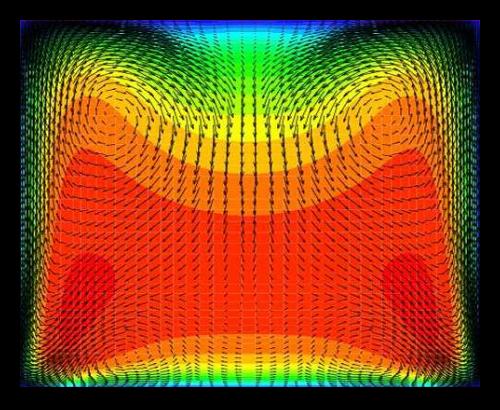 |
Large Eddy Simulation of Fluid Flow and Heat Transfer in Rotating Systems |
| Post.doc: |
Dr. Jordi Pallarès lada@chalmers.se |
| Supervisor: |
Lars Davidson lada@chalmers.se |
| Cooperation: | Escola Tècnica Superior d'Enginyeria Química, Tarragona, Spain* |
| Sponsors: | Escola Tècnica Superior d'Enginyeria Quìmica, Tarragona, Spain |
| Publications: | [1-4] |
| Start of project: | September 1998 |
THE PROJECT The main objective of this work is to simulate the turbulent flow and heat transfer in a ribbed rotating wall-heated channel. This flow is of interest because of its practical and theoretical implications. Demanding blade cooling techonolgy for industrial and aircraft turbines has motivated many of the existing studies dealing with rotating or stationary, ribbed or smooth channels. The combined effects of the density gradients, rotation and rib-induced separation demand a turbulence model being able to reproduce this complex physical situation. Turbulent flow at low Reynolds numbers in a rotating straight square duct was simulated using the large-eddy simulation technique. The rotation axis is parallel to two opposite walls of the duct, and the pressure-driven flow is assumed to be fully developed, isothermal and incompressible. The Reynolds number based on the friction velocity Retau =300 was kept constant in the range of the rotational numbers studied Rotau 1.5. Computations were carried out using a second-order finite volume code with a localized one-equation dynamic subgrid scale model. Simulations in stationary channel and duct flow and rotating channel flow were initially carried out and were seen to be in agreement with experiments and direct numerical simulations reported in the literature. The study of the flow in a rotating square duct revealed the influence of the Coriolis force on the spatial distribution of the average velocity fields and Reynolds stresses. At low rotation rates, turbulence-driven secondary flows developed near the corners convect the rotation-generated cross-stream currents. At moderate and high rotation rates, the mean secondary flow structure consists essentially of two large counter-rotating cells convecting low/high momentum fluid from the stable/unstable side to the unstable/stable side. Inspection of the terms of the transport equations of the average axial velocity and vorticity components shows the mechanisms responsible for the changes in the average flow structure. Spatial distributions of the Reynolds stresses are mainly influenced by the changes that rotation induces in the main strain rates. It has been found that, globally, at the low Reynolds number studied, rotation tends to significantly reduce the overall turbulence level of the flow. |
|
|
This page, Large Eddy Simulation of Fluid Flow and Heat Transfer in Rotating Systems, should be part of a frames system at www.tfd.chalmers.se/~lada/projects/proind.html by Webmaster: Ingalena Ljungström ilj@flowsim.se This site uses JavaScript. |